
Rare Sporting Subjects: Cricketers, Sprinter, and Sculler in Cartes-De-Visite
Cartes-De-Visite - sporting Subjects: two unknown cricketers (one hand coloured, the other by M.Moss of West Maitland, N.S.W.), a sprinter (hand coloured, by the Royal studio, George St., Sydney), and the sculler, George Perkins, the English Champion who…

Rare 1880s Circassian Albino Youth and World's Smallest Man
Two original cartes-de-visite by wood (Bourke St. East, Melbourne and George St., Sydney), circa 1880s, one depicting 'Unzie, the albino Circassian youth' and the other showing 'Dominick Sonsee, the smallest man in the world', (2).
![[Maori Interest] a group of three cartes-de-visite, circa 1870s,…](https://img.carters.com.au/300x300/4706557daf1e227ad96fad88df6578dc.jpg)
Maori Cartes-de-Visite Collection: 1870s Portraits of Men and Women
[Maori Interest] a group of three cartes-de-visite, circa 1870s, featuring Maori men and women; the images mounted on cards for T.E.Price of Masterton, G. Redfern, and one anonymous. (3).

Corranderrk Mission Residents: Kruger's 1878 Portrait Series
Frederick Kruger (1831-88), William Gillman (Goulburn tribe) and Johnny Terrick (Echuca tribe), circa 1878, albumen paper photograph carte-de-visite, overall 10.2 x 6.2 cm; with inked inscription verso 'Terrick, Gilman, Goulburn Tribe'. Known to be from a…

Pacific Islands Cartes-de-Visite Collection, 1860s: King George Tupou I
Pacific Islands: a group of cartes-de-visite, circa 1860s, comprising of a portrait of King George Tupou I of Tonga, and two other cards depicting Pacific Islanders, one female and one male, both from unknown studios. (3).

Maori Chiefs' London Visit: 1863 Portrait with Queen Victoria
Vernon Heath (Piccadilly, London), Carte-de-visite studio portrait of the Maori chiefs Kihiringi Tuahu & Kamariera Te Hau Takiri Wharepapa, photographed in 1863, during a visit to London under the sponsorship of the Wesleyan missionary, William Jenkins.…

Florence Nightingale Carte-de-Visite Photograph by H. Hering, London
Florence Nightingale albumen paper photograph on carte-de-visite by H. Hering, 137 Regent Street, London; light pencil notations front and back. Overall 10.5 x 6.2 cm.

The Queen & Prince Consort, 1860
'The Queen & Prince Consort' albumen paper photograph laid down on carte-de-visite by Mayall of 224 Regent Street, London; dated '1860' verso. Overall 10.5 x 6.2 cm.
![Elizabeth Pulman (1836-1900), Maoris - New Zealande [sic] circa…](https://img.carters.com.au/300x300/64926e4eea303df72e40d2c09bd52cb8.jpg)
Maoris of New Zealand, circa 1880, Elizabeth Pulman photograph
Elizabeth Pulman (1836-1900), Maoris - New Zealande [sic] circa 1880, carte de visite, printed lower left and lower right to margin: photograph by E. Pulman, Aukland, with title and inscription verso: Maoris New Zealande [sic], further inscribed 10-455-C,…
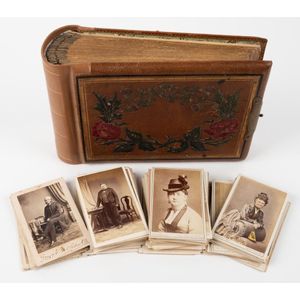
Victorian Portraits: A Collection of 19th Century Cartes-de-Visite
A collection of cartes-de-visite (approximately 80) and album. New Zealand, Australian and English photographers, 19th century
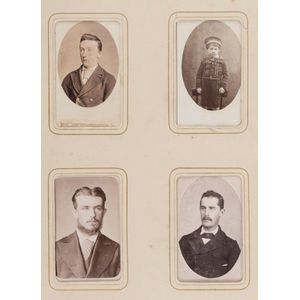
Tasmanian Cartes-De-Visite Album
Tasmania: A leather-bound album containing an extensive range of Tasmanian cartes-de-visite. Photographers noted include Anson Brothers, H.H. Baily, C. Cherry, Duval & Co., T. Nevin, C. Wherrett & Co., Wherrett & McGuffie, Alfred Winter, W. Burrows & Co.,…
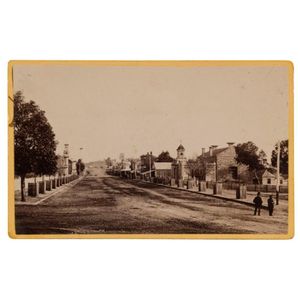
Victorian Albumen Prints of Beechworth and Richmond
James E. Bray, photographer, Beechworth, Victoria, a group of eight (8) original carte-de-visite size albumen prints laid-down on Bray cards, each titled in manuscript, including 'Ford St', 'Lunatic Asylum', 'View of Beechworth from Kerferd St', etc.;…
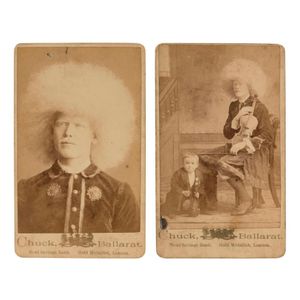
Albino Violinist Cartes-de-Visite from 19th Century Ballarat
T.F. Chuck of Ballarat: two cartes-de visite of an albino violinist, 19th century,

G. Wood & Co. Adelaide, Carte-de-Visite, 1870s
G. Wood, Son & Co. Adelaide, carte-de-visite, circa 1870s. Inscribed verso 'G. Wood, Son & Co. Adelaide, S.A.. Gilbert William wood (1828-1886) see far right of photo',
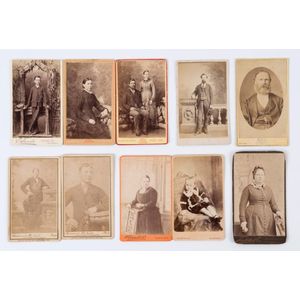
Melbourne Photographers: Portraits and Cartes-de-Visite
Photographers:Portraits, cartes-de-visite, etc., (50 items). Melbourne Photographers: Portraits, cartes-de-visite, etc., by E. Sands (Bourke St.); J. T. Seymour (Wellington St.); William Short & Co (Bourke St. East); Stevenson & McNicoll (Elizabeth St.);…

King Johnny in European Attire
King Johnny Aboriginal in European clothing, wearing a king-plate, circa 1880 carte-de-visite albumen paper print on unknown photographer's card, 10.5 x 6.5 cm.
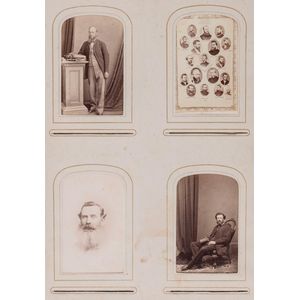
Antique Cartes-de-Visite Album from Australia
A leather-bound album containing cartes-de-visite; mainly of South Australian and Victorian origin. (199 images).

South Australian Photographers, 19th Century
Adelaide & South Australian photographers: portraits, cartes-de-visite, etc., by Thomas Adcock (King William St.); Adelaide photo Co. (Rundle St.); Adelaide photographic Co. (King William St.); Adelaide school of Photography (Rundle St.); American studio…
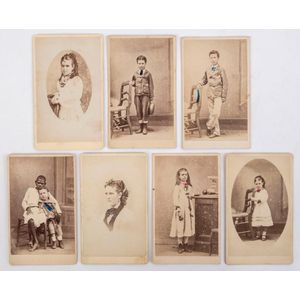
H.F. Dufty's Cartes-de-Visite Portraits from Fiji
H.F. Dufty group of seven cartes-de-visite portrait photographs including native Fijian, 19th century, reverses labelled 'F.H. Dufty Photographer Levuka, Fiji' and 'Photo by F.H. Dufty Victoria studio, Levuka, Fiji'
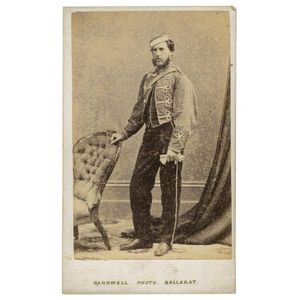
Military Portrait Carte-de-Visite from Bardwell Royal Studio Ballarat
Eureka interest: military portrait carte-de-visite photograph possibly the 40th or 12th regiment, Bardwell Royal studio, Sturt Street, Ballarat
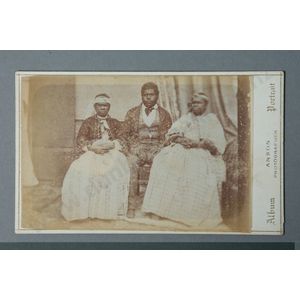
Aboriginal Portrait by Anson Brothers of Hobart
Anson Brothers (Hobart), portrait of an Aboriginal man and two women, carte de visite albumen print mounted on a photographer's card, inscribed on the verso 'Natives of Tasmania', 10 x 6.2 cm
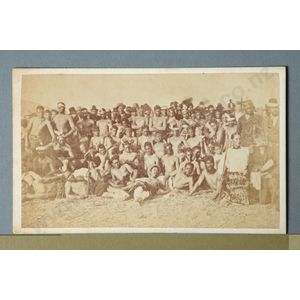
Maori Men Group Portrait by T.E. Price
Thomas Edward Price, group portrait of Maori men, carte de visite albumen print mounted on photographer's card, 10.2 x 6.2 cm
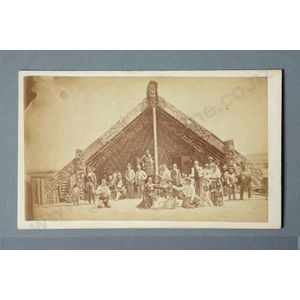
Maori Figures in Front of Wharenui Tipuna
Thomas Edward Price, group of Maori figures in front of a wharenui tipuna (dwelling), carte de visite albumen print mounted on photographer's card, 10.2 x 6.2 cm
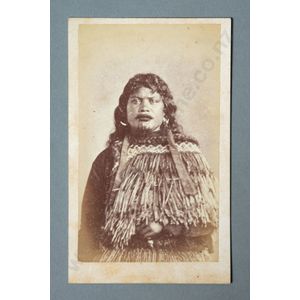
Maori Woman by Samuel Carnell (Napier)
Samuel Carnell (Napier), portrait of a Maori woman, carte de visite albumen print mounted on photographer's card, 10.2 x 6.2 cm
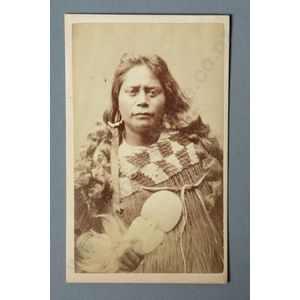
Maori Woman with Whalebone Hand Club
Thomas Edward Price, portrait of a Maori woman wearing a korowai holding a kotiate paraoa (whalebone hand club), carte de visite albumen print mounted on photographer's card, 10.2 x 6.2 cm

Maori Chief with Huia Feathers and Korowai
Samuel Carnell (Napier), portrait of a Maori chief with huia feathers in his hair and wearing a korowai, carte de visite albumen print mounted on a photographer's card, 10 x 6.2 cm
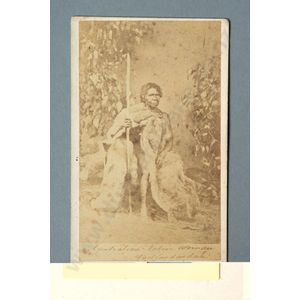
Aboriginal Woman, Carte de Visite
Portrait of an Aboriginal woman, carte de visite albumen print mounted on a photographer's card, 102 x 6.2 cm
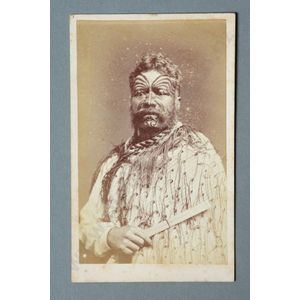
Portrait of Hami Te Hauerangi by Samuel Carnell
Samuel Carnell (Napier), portrait of Hami Te Hauerangi, carte de visite albumen print mounted on a photographer's card. 10.2 x 6.2 cm
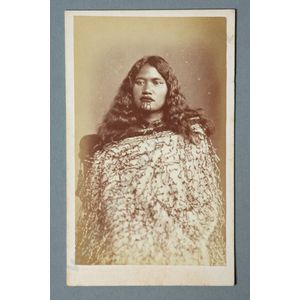
Maori Woman in Korowai by Samuel Carnell (Napier)
Samuel Carnell (Napier), portrait of a Maori woman in a korowai, carte de visite albumen print mounted on photographer's card. 10.2 x 6.2 cm
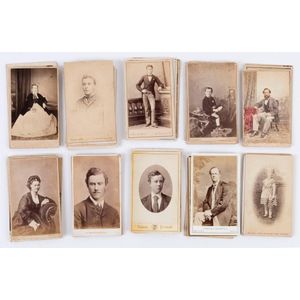
Collection of Australian and English Cartes de Visite
An accumulation of cartes de visite, mainly Australian photographers, including Wilmot & key (Geelong), Batchelder & O'Neill (Melb.), Yoeman & Co. (Prahran), Waddington & Co. (Melb.), Davies & Co. (Melb.), Turner's (Geelong), Gaul & Dunn (Melb.), T.S…
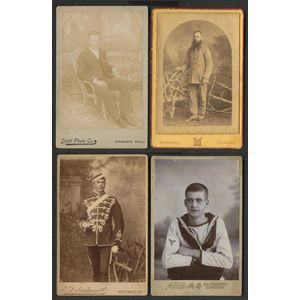
Portraits by international photographers
Queensland, other Australian, New Zealand & other foreign photographers: portraits, cartes-de-visite, etc., including the work of Henry Goode (Rockhampton), Hansen Lundager (Rock'ton), Mathewson (Brisbane), McCleeand & Goode (Rock'ton), J. Watson…
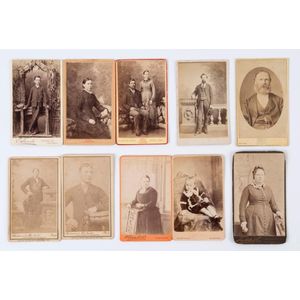
Melbourne Photographers of the 19th Century
Melbourne photographers: portraits, cartes-de-visite, etc., by E. Sands (Bourke St.), J. T. Seymour (Wellington St.), William short & Co (Bourke St. East), Stevenson & McNicoll (Elizabeth St.), Stewart & Co. (Bourke St. East), Stewart & Co. (Bourke St.),…
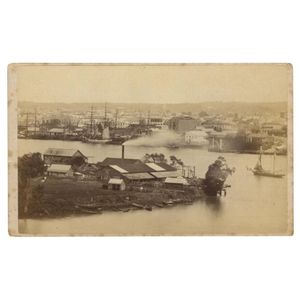
Early Brisbane: 1870 Riverfront and City Views
Early Brisbane: group of seven cartes de visite by J.Watson of Queen Street, Brisbane, showing detailed early river front and city views, circa 1870., Watson occupied premises in Queen Street between 1862 and 1875.
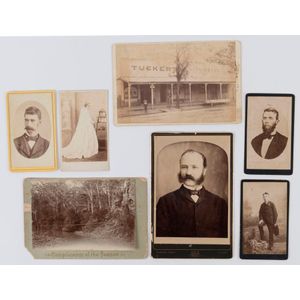
NSW Photographers: Portraits & Cartes-de-Visite
Sydney & New South Wales photographers: portraits, cartes-de-visite, etc., by Besse && Edwards (Bega), William Bradley (Pitt St.), F.A. Breen (Nowra), Burton Bros (Albury), R. Caspers (Goulburn), Clarke Bros. (Windsor), W.H. Crago (Sydney), Elite studio…
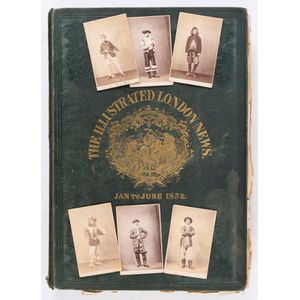
Goldfields Theatrical Troupe and Illustrated News (7 items)
Australian goldfields group of six cartes de visite of a theatrical troupe taken in Castlemaine Victoria, together with an 1852 edition of the London illustrated news with Victorian gold rush motif on the cover. (7 items)
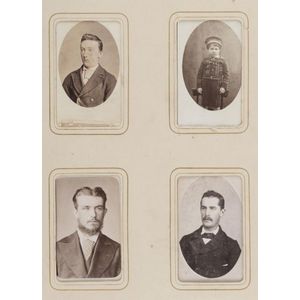
Tasmanian Cartes-de-Visite: A Photographer's Collection
Tasmania: A leather-bound album containing an extensive range of Tasmanian cartes-de-visite. Photographers noted include Anson Brothers, H.H. Baily, C. Cherry, Duval & Co., T. Nevin, C. Wherrett & Co., Wherrett & McGuffie, Alfred Winter, W. Burrows & Co.,…
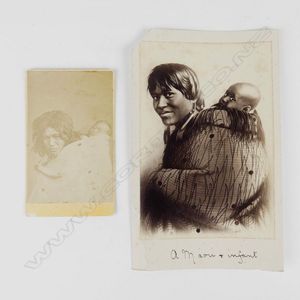
Maori Woman and Child in Muka Cloak
An early photo of a Lindauer painting and a carte de visite attributed to Elizabeth Pulman, both images of a Maori woman wearing muka cloak with child to their back. 14 x 9.5 cm and 9.5 x 6 cm.
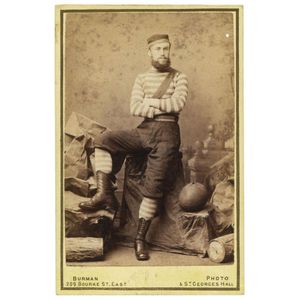
1880 Footballer in Melbourne Studio Portrait
A bearded footballer in full playing outfit with inflated oval ball at his side, circa 1880, Albumen print photograph, carte de visite format, 102 x 64 mm, verso imprinted 'From Burman's Photographic Rooms, 209 Bourke St. East, near Parliament Houses and…
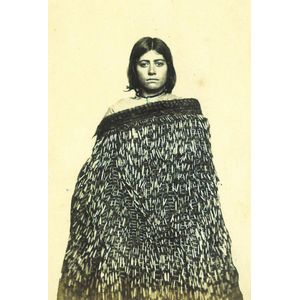
Unidentified Cartes de Visite from 19th Century New Zealand
Five Mid/Late-19th century New Zealand Cartes de Visite, all albumen silver prints, unknown, untitled. Young woman wearing feather cloak. C.1860-90. 8 x 5.5 cm., attributed to Burton Brothers, portrait of Ratene Hihitawa, ngati Pakenga of Tauranga. C.1870…
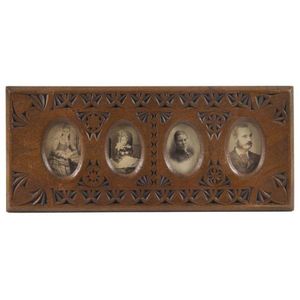
Newton Family Carte de Visite Picture Frame
Isaac Albert Newton four panelled picture frame with carte de visite portraits of the Newton family, 19th/20th century, 18 x 41 cm overall. Provenance: Direct family descent
![Deslandes, John [Victorian Gold Rush] Carte de visite format…](https://img.carters.com.au/300x300/523ff3d1b91e9ff8873a8c624e06a786.jpg)
Victorian Gold Rush Nugget Photograph by John Deslandes
Deslandes, John [Victorian Gold Rush] Carte de visite format albumen print photograph of a gold nugget, with hand colouring in gold; recto with the imprint of J.Deslandes, Photographic Artist, Inglewood.' The card with contemporary inscription in ink:…
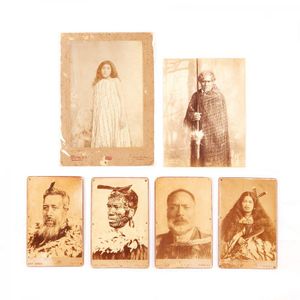
Foy Brothers Maori Portrait Collection
A collection of Foy Brothers Maori portrait photographs, c1872-1886, black and white carte de visite photographic print, Pare Whakerongomai (Pare Watene), 16.5 x 10.8 cm, verso 164. Pare Whakerongomai, Hori Ngakapa Te Whanaunga, 16.8 x 10.6 cm, verso 258.…
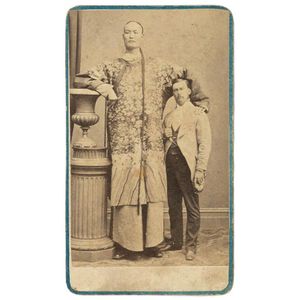
Chang Woo Gow, the Chinese Giant, in Australia 1870
(Chang Woo Gow 1841 - 1893), Chang the Chinese Giant, Ballarat, 1870, Albumen print photograph of carte-de-visite 106 x 62 mm, verso imprinted for Bardwell's Royal Studio, Opposite the Theatre Ballarat. Chang Woo Gow (born in Canton, China) visited…
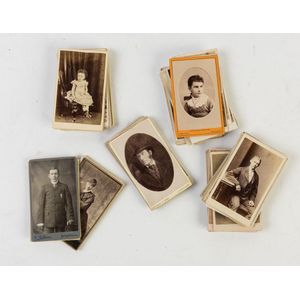
Australian Carte de Visite Portrait Collection
Collection of 85 carte de visite portrait photographs, many Australian examples
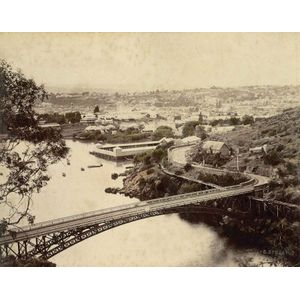
Collection of 1870s-90s Tasmania Albumen Photographs
Tasmania: A collection of 1870s-90s albumen photographs laid down on pages or card, various sizes. Subjects mostly annotated in a contemprary hand and include 'Abandoned Penal Establishment, Salt Water River', Hobart Town Harbour 6th April 1880,…
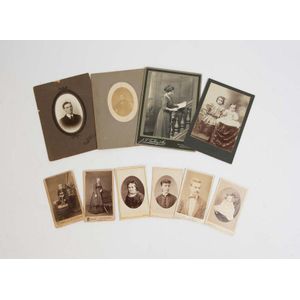
Australian 19th Century Portrait Collection
A collection of predominantly Australian carte de visite and salon portraits, 19th century, inspection will reward
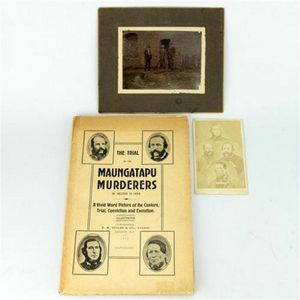
Burgess Bushranger Gang Carte de Visite and Related Items
Burgess Bushranger Gang 1866 Carte de Visite by Captain Coulston showing the Victorian bushrangers Philip Levy, Richard Burgess, Thomas Kelly (Noon) & Joseph Thomas Sullivan, most famous for the Maungatapu Murders in New Zealand, plus a 1924 book on the…
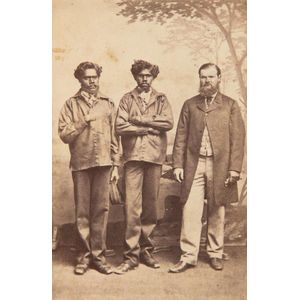
William Landsborough and Aboriginal Trackers in Carte-de-Visite Photograph
Batchelder and O'Neill photographers: Carte-de-VIsite photograph depicting William Landsborough and two Aboriginal trackers, Jemmy and Jack Fisherman. circa 1862. Landsborough led a search for Burke and Wills after their disappearance.10 x 6.5 cm
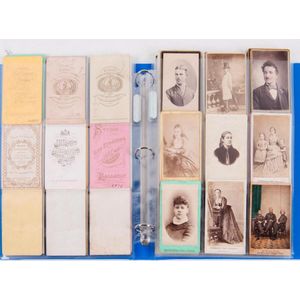
Ballarat Carte de Visite Photographs
Carte de Visite photographs by Ballarat photographers, includes one showing a carriage in front of a house; and another of a man wearing what appears to be a masonic collar.
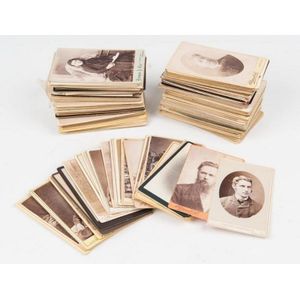
Victorian Photograph Collection: Cartes de Visite and Tintype
Carte de Visite photographs (175) by Victorian photographers, one an earlier tintype photograph.
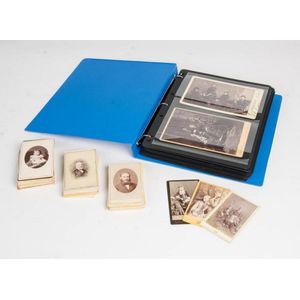
Australian Antique Photo Collection
Carte de Visite photographs (198) & Cabinet Card photographs (30) by Australian photographers, plus range earlier tintype photographs (10).

Young Ngati Maru Woman in Traditional Attire
Foy Brothers (Thames). Portrait of a young Ngati Maru woman wearing korowhai and hei tiki. Original carte de visite, c. 1865
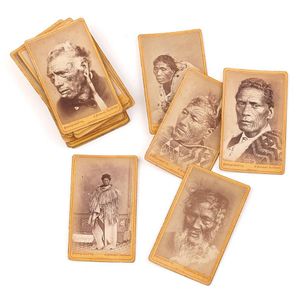
Rare Maori Portraits by Elizabeth Pulman, c1870s
The Glew collection of rare carte de visite/ albumen prints by Elizabeth Pulman, Auckland, c1870's. Print sizes generally: 90 x 5.5 cm. Three images have been cropped to an oval by the photographer. Mild fading and wear to prints. This exceptional…
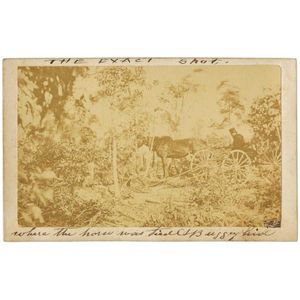
19th Century Murder Scene and Wanted Criminals Photographs
Piggoreet Murder: Facinating group of 19th century photograph including 3 captioned carte de visites of the murder scene near Ballarat showing where Mr Ballan shot Mr T Ulicke Burke, 'Black trackers finding the pistol', 'The exact spot.....', & 'The tree…
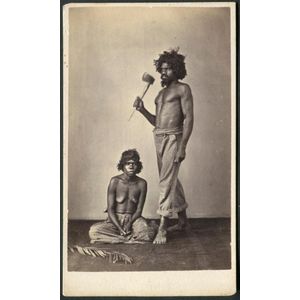
Aboriginal and Historical Portraits Collection
Aboriginal carte de visite by S.Duesbury of Brisbane c1870; carte de visite, 'One Thousand Portraits of Living & Historical Celebrities'; J. W. Lindt cabinet portrait of a gent; & a carte de visite portrait.(4 items)
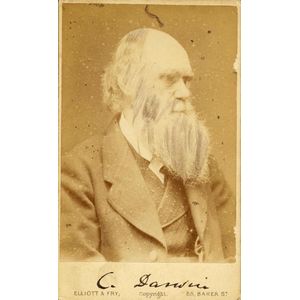
Charles Darwin Autographed Carte de Visite
Charles Darwin: printed autograph on carte de visite by Elliott and Fry of London c1870. good condition
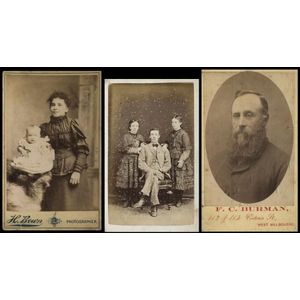
Cdv Photographs 1850-1880s: English Collection
Album of Carte-de-visite photographs c1850-1880s, mainly English photographers. mixed condition (140 items)
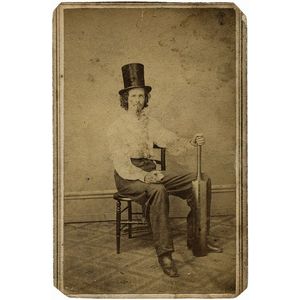
Cricketer Portrait by Rodgers of Hamilton Ohio (c1865)
Cricket Carte de visite: Photo portrait of a seated cricketer (c1865) by Rodgers of Hamilton Ohio. Sitters name & some details also on the reverse in ink (William Lauder?). Rare piece. Corners trimmed
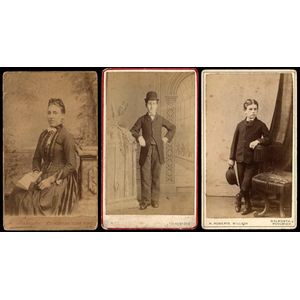
Early Australian Photographers' Carte-de-visite Collection
Group of 'Carte-de-visite' photographs. Many early Australian photographers including Nettleton, [Melbourne, Geelong, Ballarat and the U.K.]. (83)
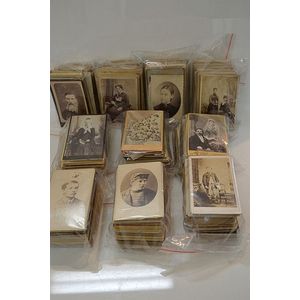
300+ Cartes-Des-Visites Collection Album
Collection of Cartes-Des-Visites over 300 images backing card 1.2 cm high, 6.3 cm wide other notes album 18

Vintage Portrait Collection
Collection of studio cards, cartes-des-visites and tin types approximately 100-175 images various sizes
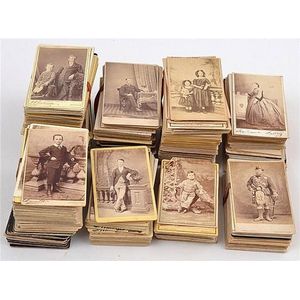
N.J. Caire Carte de Visite Portrait Collection
Large collection of carte de visite including Portraits by N.J. Caire

Darwin and Elephant Cartes-de-Visite
Cartes-de-visite depicting Charles Darwin in later life (2 different) and another depicting 'The Mother Elephant 'Hebe' and her baby 'Young America' (3)

"Native Blackfellow" Carte de Visite, c1868
C. E. Bevan, Edward St., Brisbane: 'Native Blackfellow' carte de visite, c1868

'Native Gin from Brisbane'
C. E. Bevan, Edward St, Brisbane: 'Native Gin (Australia)' carte de visite


 Loading more...
Loading more...